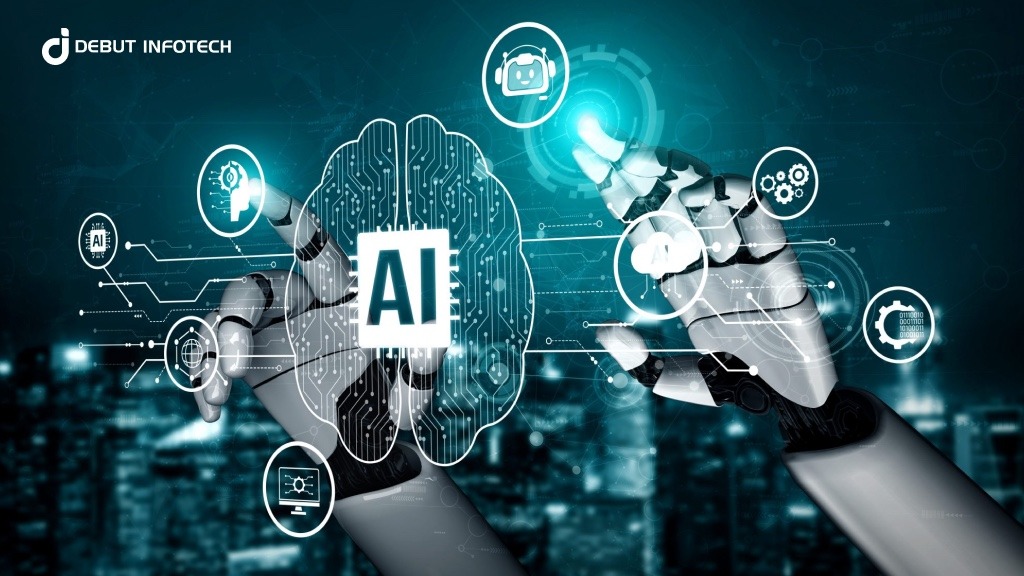Generative AI is no longer a futuristic notion; it is now one of the main engines of innovation in all industries. Generative AI is rapidly developing, not only with personalized marketing campaigns but also with AI-assisted coding. Additionally, Generative AI trends are helping businesses remain competitive and define new markets, products, and customer experiences. It is believed that 2026 will be a turning point where generative AI programs will become mainstream in business operations and be backed with stronger frameworks, scale, and integration services.
Firms are investing more in the development of generative AI applications to unlock new value, with this development rising in adoption. The technology is transforming the operations of industries through generative AI in business processes, as well as in the areas of design, the medical field, finance, and entertainment. With advancements in neural activation and model training, generative AI systems are becoming more adaptive and efficient. The blog will examine the most popular generative AI market trends that will define 2026, the main opportunities, and how the company Debut Infotech, one of the leading AI development companies, can assist enterprises in implementing the generative AI solutions of the future.
Key Takeaways
- Generative AI trends are reshaping industries and becoming essential for competitive advantage by 2026.
- Businesses will leverage generative AI for efficiency, new revenue streams, and improved customer experiences across healthcare, finance, retail, and entertainment.
- Growing demand for generative AI frameworks and platforms will drive innovation and speed up application development.
- Ethical AI, customization, and seamless integration with legacy systems will be crucial focuses in adopting generative AI trends.
- Partnering with experts like Debut Infotech will help organizations maximize the value of generative AI solutions and navigate market opportunities.
Table of Contents
- The Generative AI Market Landscape in 2026
- Expanding Use of Generative AI Applications Across Industries
- Rise of Generative AI Frameworks and Platforms
- Popular Generative AI Programs Leading 2026
- Generative AI Trends: The Future Facing Outlook
- Hiring Generative AI Developers for Competitive Edge
- Key Generative AI Examples Defining the Next Era
- How Debut Infotech Can Help with Generative AI Trends and Development
- Conclusion
The Generative AI Market Landscape in 2026
The generative AI market trends of 2026 are marked by explosive growth. Analysts project billions in market valuation as generative AI applications become deeply embedded in enterprise ecosystems. Unlike the early adoption stages of 2023–2024, 2026 will witness a more mature generative AI landscape, with enterprises moving from experimentation to scaling production-ready generative AI software.
Key drivers include:
- Advances in generative AI trends and models, such as multimodal systems combining text, voice, image, and video.
- The democratization of generative AI platforms that allow even non-technical users to build AI-driven solutions.
- Growing demand for generative AI integration services to embed AI into existing IT infrastructure.

This combination signals a shift toward future-facing generative AI, where adoption is not optional but essential for competitive advantage.
Expanding Use of Generative AI Applications Across Industries
Generative AI rapidly moves from niche creative tools to enterprise-grade solutions, reshaping industries. By 2026, organizations will rely on generative AI for efficiency, unlocking new revenue streams, improving customer satisfaction, and streamlining complex processes.
- Healthcare: Beyond generating synthetic medical data for safer and more robust research, generative AI is being integrated into diagnostic support systems. Doctors can use AI copilots to interpret medical images, predict patient outcomes, and recommend treatment plans tailored to genetic and lifestyle factors. Pharmaceutical companies also leverage generative AI to design new drug molecules, cutting years off the traditional R&D cycle.
- Finance: Banks and fintech companies are embedding generative AI into daily operations. AI models can create automated, highly visual investment reports, simulate fraud detection scenarios to enhance security, and develop risk assessment models more accurately. Generative AI personalizes portfolio strategies in wealth management, giving clients a more data-driven and customized experience.
- Retail & E-commerce: The retail sector is adopting generative AI to redefine the shopping journey. AI-driven product recommendations now go beyond past purchases, analyzing customer behavior, browsing habits, and even mood patterns. Virtual try-on tools powered by generative AI allow customers to visualize clothing, accessories, or furniture before buying. Additionally, customer service is transformed with conversational AI assistants capable of resolving complex queries in real time.
- Entertainment: The entertainment industry is perhaps the most visible showcase of generative AI’s creativity. Musicians use AI to compose tracks personalized to listener preferences, while game developers design dynamic characters that evolve based on player interactions. Scriptwriters and film studios are experimenting with AI to co-write scenes, generate storyboards, and streamline post-production editing.
These advancements reveal that generative AI is no longer a futuristic concept but a practical technology driving measurable business outcomes. Its applications cut across healthcare, finance, retail, and entertainment, making it a cornerstone of business growth strategies in 2026 and beyond.
Rise of Generative AI Frameworks and Platforms
By 2026, generative AI frameworks will be the backbone of most enterprise solutions. Frameworks like PyTorch, TensorFlow, and emerging custom AI development tools enable developers to build scalable, secure, and high-performing generative AI applications.
Meanwhile, generative AI platforms will continue to evolve, offering pre-trained models, drag-and-drop features, and plug-ins for faster generative AI application development. This trend reduces time-to-market while empowering companies to experiment with AI-driven innovation.
Companies seeking speed, scalability, and flexibility will increasingly turn to generative AI development companies that integrate these frameworks into business-ready platforms.
Popular Generative AI Programs Leading 2026
Generative AI programs are evolving at an unprecedented pace. By 2026, businesses will see a range of specialized solutions that cater to different needs:
- Design & Creativity Programs: Tools that generate brand logos, ad campaigns, and 3D prototypes.
- Code-Assistants: Programs that help developers by suggesting or even auto-writing functional code.
- Business Productivity Programs: AI copilots integrated into CRMs, ERPs, and project management systems.
- Simulation Programs: Generating real-world scenarios for training autonomous systems or testing supply chain resilience.
These innovations reflect how generative AI software is becoming indispensable in enterprise workflows.
Generative AI Trends: The Future Facing Outlook

Some initial hype cycles around generative AI have matured, leaving the market with clearer and more stable adoption patterns. By 2026, businesses will no longer ask if they should adopt generative AI but how they can best leverage it for measurable value. The following generative AI market trends are shaping this new era:
Ethical and Responsible AI
The demand for transparent AI models is stronger than ever. Businesses and regulators prioritize ethical AI systems that can explain decisions and reduce bias. This means generative AI development companies must integrate fairness, accountability, and governance into every solution they build.
Enterprise-Grade Security
As generative AI applications handle vast amounts of sensitive information, AI data security becomes a top priority. From customer identity details to proprietary business insights, enterprises invest in AI systems with built-in encryption, secure APIs, and real-time threat monitoring to prevent breaches.
Customization over Generic Models
Off-the-shelf AI tools are no longer enough. Businesses now want customized generative AI applications that fit their industry needs, integrate seamlessly with their operations, and align with their brand voice. Working with a generative AI development company ensures tailored solutions instead of one-size-fits-all programs.
Integration with Legacy Systems
Most enterprises cannot abandon their existing IT ecosystems, which is why generative AI integration services are critical. AI tools must be able to work alongside legacy ERP, CRM, and cloud platforms, enabling smooth workflows without disrupting day-to-day operations. This trend is especially vital for industries like banking, healthcare, and manufacturing, where legacy systems are deeply embedded.
Scalable Deployment
Global businesses need cloud-native and edge computing capabilities to ensure AI services are available across geographies. Scalable deployment makes it possible to expand AI usage without costly infrastructure upgrades. By 2026, hybrid models—where AI runs on centralized clouds and edge devices—will dominate enterprise deployments.
The Bigger Picture
Together, these future-facing generative AI trends reflect a market that is no longer experimenting but strategically deploying AI for growth, efficiency, and innovation. For businesses, success means aligning with the right partners and technologies that bridge innovation with compliance, scalability, and security.
Hiring Generative AI Developers for Competitive Edge
As demand grows, businesses will increasingly hire generative AI developers skilled in building and scaling AI systems. By 2026, talent gaps will remain challenging, but working with a generative AI development company ensures access to experienced professionals who understand technical frameworks and business strategies.
An expert team brings value in:
- Designing scalable AI architectures.
- Building specialized generative AI applications aligned with unique business needs.
- Integrating AI seamlessly into platforms with minimal disruption.
- Offering ongoing updates and support as the generative AI landscape evolves.
Key Generative AI Examples Defining the Next Era
To better understand adoption, let’s look at some generative AI examples expected to dominate 2026:
- Generative AI in Marketing: Hyper-personalized ad campaigns generated at scale.
- Generative AI in Education: Customized learning modules for individual students.
- Generative AI in Manufacturing: AI-generated designs for faster prototyping.
- Generative AI in Customer Service: AI copilots providing real-time, human-like support.
These examples underscore how generative AI for business is driving innovation across verticals.
How Debut Infotech Can Help with Generative AI Trends and Development
When businesses look to embrace generative AI trends, they need more than just software—they need strategic partners who understand the nuances of AI deployment. That’s where Debut Infotech, a trusted AI development company, stands out.
Debut Infotech offers:
- Generative AI Integration Services to seamlessly embed AI into your existing infrastructure.
- End-to-end generative AI application development, from ideation to deployment.
- Access to skilled teams if you want to hire generative AI developers for custom solutions.
- Deep expertise across industries ensures your generative AI for business initiatives align with market opportunities.
Whether it’s building AI copilots, enterprise-grade generative AI frameworks, or sector-specific generative AI applications, Debut Infotech ensures businesses unlock value and scale securely.
Conclusion
The year 2026 will be pivotal in shaping the generative AI landscape, as businesses fully embrace the power of AI-driven innovation. From generative AI models and platforms to real-world generative AI applications across industries, companies that follow emerging generative AI market trends will secure a stronger foothold in the global economy.
Partnering with the right experts is key. With Debut Infotech’s expertise in generative AI development services, companies can confidently build future-ready solutions, mitigate risks, and leverage cutting-edge generative AI technology to drive growth. Ultimately, those who adopt future-facing generative AI trends and strategies today will define the winners of tomorrow’s business world.











